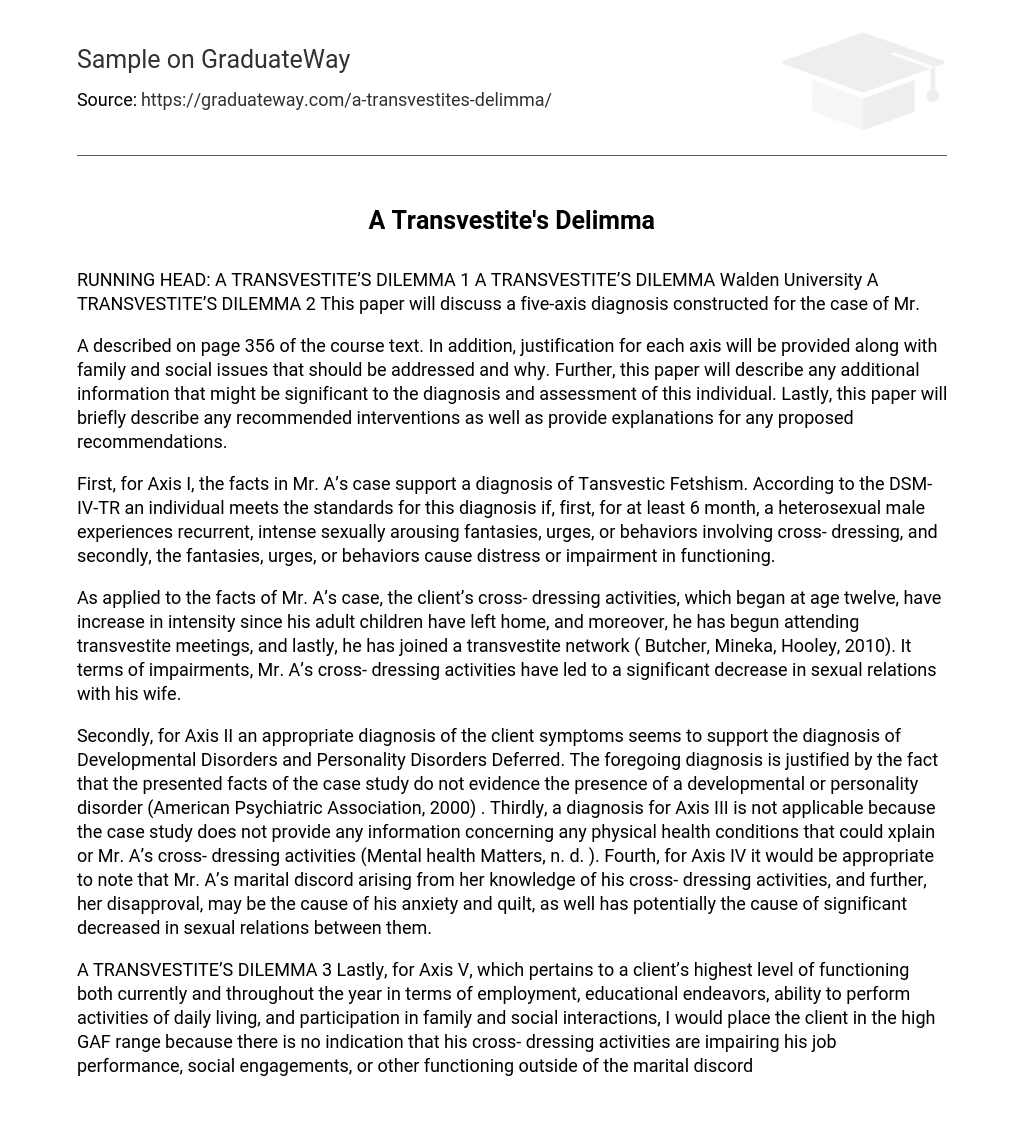- First, for Axis I, the facts in Mr. A’s case support a diagnosis of Tansvestic Fetshism. According to the DSM-IV-TR an individual meets the standards for this diagnosis if, first, for at least 6 month, a heterosexual male experiences recurrent, intense sexually arousing fantasies, urges, or behaviors involving cross- dressing, and secondly, the fantasies, urges, or behaviors cause distress or impairment in functioning. As applied to the facts of Mr. A’s case, the client’s cross- dressing activities, which began at age twelve, have increase in intensity since his adult children have left home, and moreover, he has begun attending transvestite meetings, and lastly, he has joined a transvestite network ( Butcher, Mineka, Hooley, 2010). It terms of impairments, Mr. A’s cross- dressing activities have led to a significant decrease in sexual relations with his wife.
- Secondly, for Axis II an appropriate diagnosis of the client symptoms seems to support the diagnosis of Developmental Disorders and Personality Disorders Deferred. The foregoing diagnosis is justified by the fact that the presented facts of the case study do not evidence the presence of a developmental or personality disorder (American Psychiatric Association, 2000) .
- Thirdly, a diagnosis for Axis III is not applicable because the case study does not provide any information concerning any physical health conditions that could xplain or Mr. A’s cross- dressing activities (Mental health Matters, n. d. ).
- Fourth, for Axis IV it would be appropriate to note that Mr. A’s marital discord arising from her knowledge of his cross- dressing activities, and further, her disapproval, may be the cause of his anxiety and quilt, as well has potentially the cause of significant decreased in sexual relations between them.
Lastly, for Axis V, which pertains to a client’s highest level of functioning both currently and throughout the year in terms of employment, educational endeavors, ability to perform activities of daily living, and participation in family and social interactions, I would place the client in the high GAF range because there is no indication that his cross- dressing activities are impairing his job performance, social engagements, or other functioning outside of the marital discord.
Notably, in order to make a more accurate Axis 5diagnosis and corresponding treatment recommendations, more information would need to be ascertained such as whether or not the decrease in sexual activity between Mr. A and his wife is due to his growing sexual attraction to other males, and similarly, whether or not he has begun desiring sexual reassignment as a woman. Just as importantly it would be important to ingure if he is still sexually attracted to females, or males and female.
For example, if warranted Mr. A’s Axis 1 diagnosis could change to Gender Identity Disorder or Gender Identity Disorder Not Otherwise Specified, Moreover, just because he may at some point desire a sexual reassignment, he may continue to be exclusively sexually attracted to females. Next, in terms of family and social issues that should be addressed and any recommended treatment interventions, at this point, I would recommend that Mr. A and his wife enter couples counseling as well as individual counseling.
Issues that could be explored in both couples counseling as well as individual counseling with his wife include, but would not be limited to recommending that she seek out support by joining a support group led by woman married to cross- dressing males. Perhaps through support as well as taking a different view toward her husband’s cross dressing their marriage could be save. For example, at least one recent study on the phenomenon of married heterosexual cross- dressing males has found that when wives ppreciate the benefits of their husband’s enjoyment of dressing like a women and regularly helping with housework, their marriage and sex life improved (Hill, 2011).
Lastly, ethical issues include, but would not be limited to refraining from letting bias impair the counselor’s treatment approaches and “providing support for transgender persons not expressing their authentic gender and choose to remain closeted” ( American Counseling Association, 2005; Rachlin & Lev, 2011).
References
- American Counseling Association ( 2005) Ethical codes of conduct. Retrieved on April 28, 2013 from www. counseling. org/Resources/aca-code-of-ethics. pdf
- Butcher, J. N. , Mineka, S. , & Hooley, J. M. (2010). Abnormal psychology (14th ed. ). Boston, MA: Allyn & Bacon. Hill, R. 9 20110.
- Section II Sexuality: “ We share a sacred secret” gender, domesticity, and containment in transvestia’s histories and letters from crossdresser and their wives, Journal of social history, 4: 730-747
- Rachlin, A. I. & Lev, A. I. ( 2011). Challenging cases for experienced therapist. Journal of gay and lesbian mental health, 15:180-199.
- Mental Health Matters (n. d. ). Brief explanation of a 5 Axis Diagnosis. Retrieved on April 7, 2013 from http://www. dhs. state. or. us/caf/safety_model/procedure_manual/appendices/ch4-app/4-5. pdf





